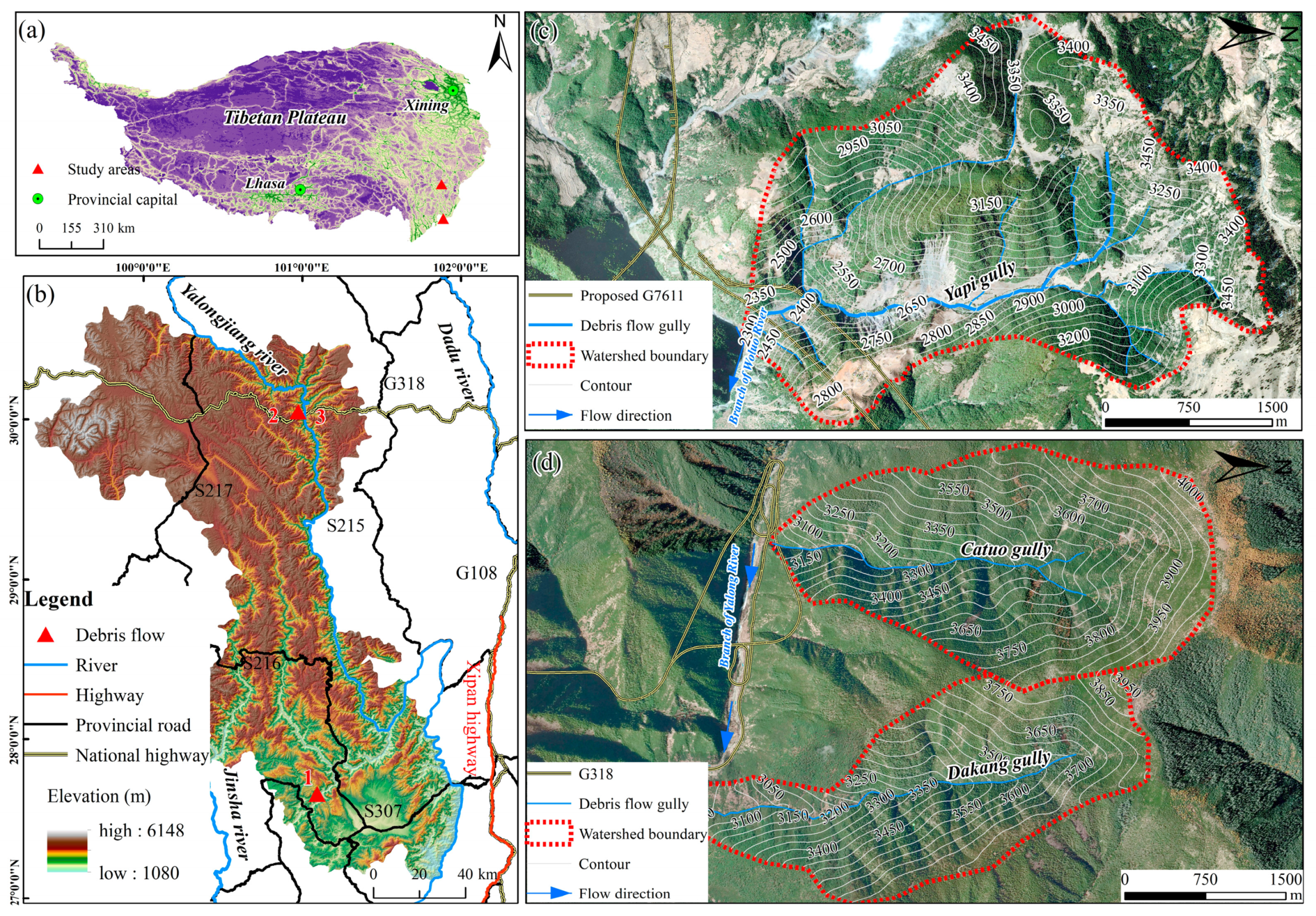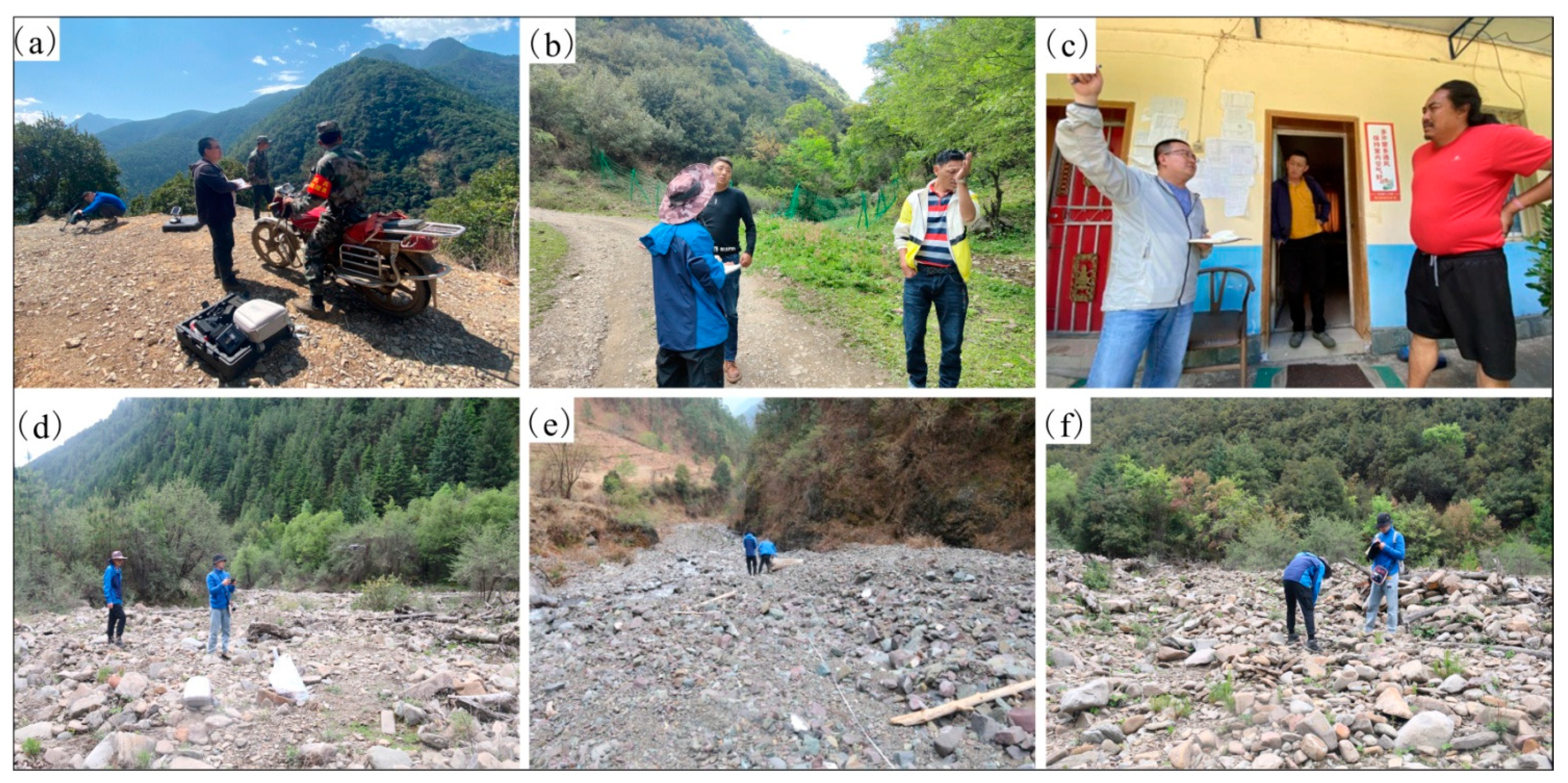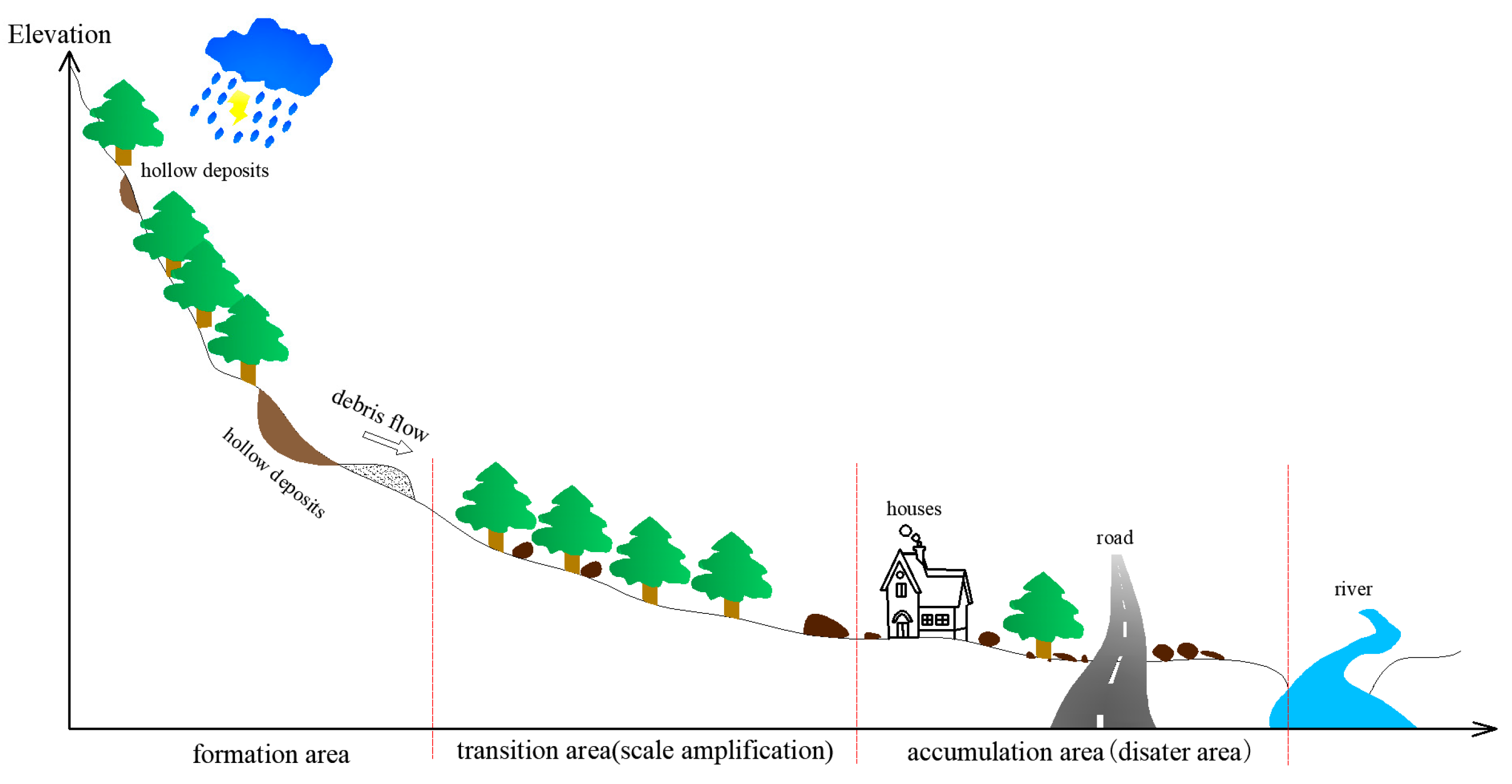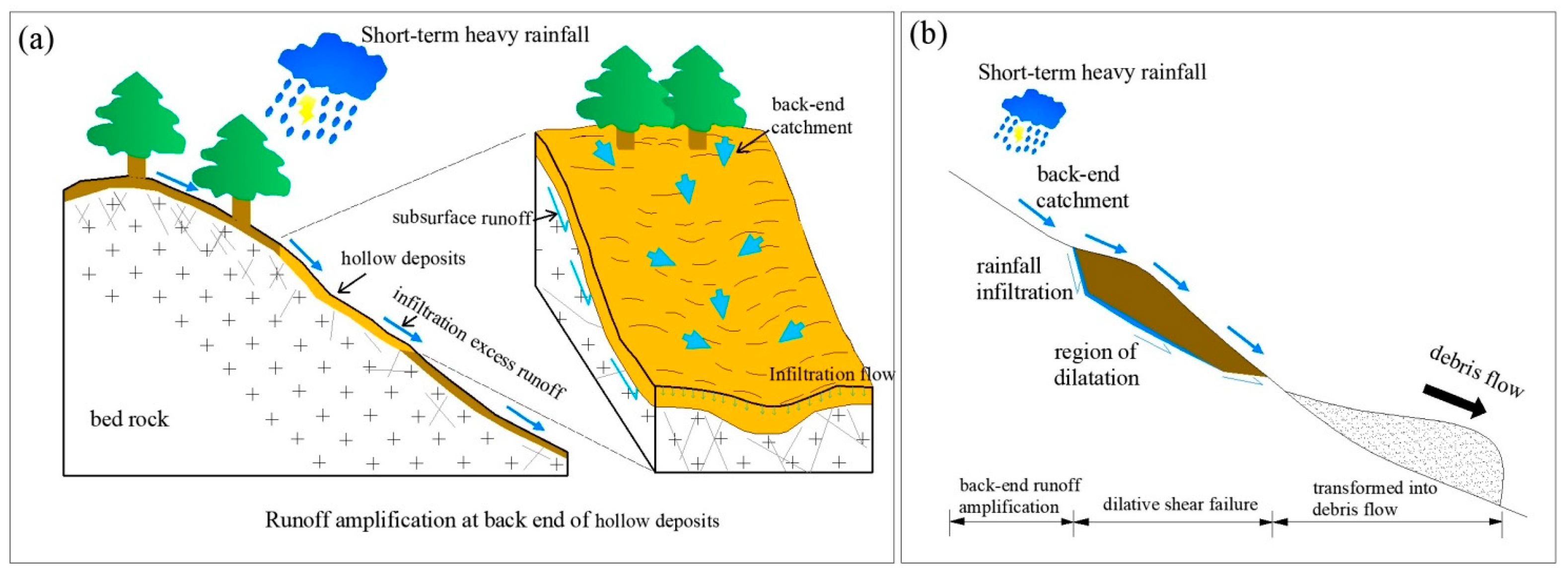Method on Early Identification of Low-Frequency Debris Flow Gullies along the Highways in the Chuanxi Plateau
Abstract
1. Introduction
2. Materials and Methods
2.1. Study Area
2.2. Methodology
2.2.1. Field Investigation and On-Site Interviews
2.2.2. Identification and Stability Calculation of CDH
- (1)
- Identification of CDH
- (2)
- Stability calculation of CDH
- i
- Determination of the average gradient (i) of the CDH.
- ii
- Determination of the average thickness (h) of CDH.
- iii
- Stability analysis
2.2.3. Calculation of Roundness Value of the Stones in Debris Flow Deposit Fan
3. Results
3.1. Identification of Low-Frequency Debris Flow Gully without Deposit Fan
3.2. Identification of Low-Frequency Debris Flow Gully with Deposit Fan
3.3. Identification System of Low-Frequency Debris Flow Gullies and Its Verification
4. Discussion
4.1. Principles for the Identification Method of Low-Frequency Debris Flow Gullies
4.2. Limitations
5. Conclusions
Supplementary Materials
Author Contributions
Funding
Data Availability Statement
Acknowledgments
Conflicts of Interest
References
- Chen, H.; Tang, H.; Ye, S. Study on debris flows along highways in China. Chin. J. Geol. Hazard Control 2008, 19, 5–9. (In Chinese) [Google Scholar]
- Yan, X.F.; Xu, H.; Lu, H.; Zhou, J.W.; Wang, L. Assessment and Analysis of a Rainfall-Time-Lagging Water-Related Disaster in Mountainous Areas. Front. Earth Sci. 2021, 9, 659708. [Google Scholar] [CrossRef]
- Zhong, Z.; Chen, N.; Hu, G.; Han, Z.; Ni, H. Aggravation of debris flow disaster by extreme climate and engineering: A case study of the Tongzilin Gully, Southwestern Sichuan Province, China. Nat. Hazards 2021, 109, 237–253. [Google Scholar] [CrossRef]
- Zhu, J.; Ding, J.; Liang, J.T. Influences of the Wenchuan Earthquake on sediment supply of debris flows. J. Mt. Sci. 2011, 8, 270–277. [Google Scholar] [CrossRef]
- Chen, N.S.; Hu, G.S.; Deng, M.F.; Zhou, W.; Yang, C.L.; Han, D.; Deng, J.H. Impact of earthquake on debris flows—A case study on the Wenchuan earthquake. J. Earthq. Tsunami 2011, 5, 493–508. [Google Scholar] [CrossRef]
- Zhou, W.; Tang, C. Rainfall thresholds for debris flow initiation in the Wenchuan earthquake-stricken area, southwestern China. Landslides 2014, 11, 877–887. [Google Scholar] [CrossRef]
- Tie, Y.; Jiang, J.; Song, Z.; Kadetova, A.V.; Rybchenko, A.A. Frequency Difference of Debris Flows in Moxi Basin, Southwestern China. In Proceedings of the 4th World Landslide Forum, Ljubljana, Slovenia, 29 May–2 June 2017; pp. 415–420. [Google Scholar]
- van Steijn, H. Debris-flow magnitude—Frequency relationships for mountainous regions of Central and Northwest Europe. Geomorphology 1996, 15, 259–273. [Google Scholar] [CrossRef]
- Zhao, Y.; Meng, X.; Qi, T.; Qing, F.; Xiong, M.; Li, Y.; Guo, P.; Chen, G. Al-based identification of low-frequency debris flow catchments in the Bailong River basin, China. Geomorphology 2020, 359, 107125. [Google Scholar] [CrossRef]
- Tian, S.; Hu, G.; Chen, N.; Rahman, M.; Han, Z.; Somos-Valenzuela, M.; Maurice Habumugisha, J. Extreme climate and tectonic controls on the generation of a large-scale, low-frequency debris flow. Catena 2022, 212, 106086. [Google Scholar] [CrossRef]
- Zhang, Y.; Chen, N.; Liu, M.; Wang, T.; Khanal, B.R. Debris flows originating from colluvium deposits in hollow regions during a heavy storm process in Taining, southeastern China. Landslides 2019, 17, 335–347. [Google Scholar] [CrossRef]
- Wang, G.L. Lessons learned from protective measures associated with the 2010 Zhouqu debris flow disaster in China. Nat. Hazards 2013, 69, 1835–1847. [Google Scholar] [CrossRef]
- Pérez, F. Matrix granulometry of catastrophic debris flows (December 1999) in central coastal Venezuela. Catena 2001, 45, 163–183. [Google Scholar] [CrossRef]
- Costa, J.E.; Fleisher, P.J. Physical Geomorphology of Debris Flows; Springer: Berlin/Heidelberg, Germany, 1984; pp. 268–317. [Google Scholar] [CrossRef]
- Brunsden, D. Slope Instability; John Wiley & Sons: Hoboken, NJ, USA, 1984. [Google Scholar]
- Yang, Z.; Zhao, X.; Chen, M.; Zhang, J.; Yang, Y.; Chen, W.; Bai, X.; Wang, M.; Wu, Q. Characteristics, Dynamic Analyses and Hazard Assessment of Debris Flows in Niumiangou Valley of Wenchuan County. Appl. Sci. 2023, 13, 1161. [Google Scholar] [CrossRef]
- Bovis, M.J.; Jakob, M. The role of debris supply conditions in predicting debris flow activity. Earth Surf. Process. Landf. 1999, 24, 1039–1054. [Google Scholar] [CrossRef]
- Welsh, A.; Davies, T. Identification of alluvial fans susceptible to debris-flow hazards. Landslides 2011, 8, 183–194. [Google Scholar] [CrossRef]
- Smith, T.C. A method for mapping relative susceptibility debris avalanches with an example from San Mateo County. U. S. Geol. Surv. Prof. Pap. 1988, 1434, 185–194. [Google Scholar]
- Rowbotham, D.; Louis, S.J. The identification of debris torrent basins using morphometric measures derived within a gis. Geogr. Ann. 2005, 87, 527–537. [Google Scholar] [CrossRef]
- Bertrand, M.; Liébault, F.; Piégay, H. Debris-flow susceptibility of upland catchments. Nat. Hazards 2013, 67, 497–511. [Google Scholar] [CrossRef]
- Zhou, W.; Tang, C.; Van Asch, T.W.J.; Chang, M. A rapid method to identify the potential of debris flow development induced by rainfall in the catchments of the Wenchuan earthquake area. Landslides 2016, 13, 1243–1259. [Google Scholar] [CrossRef]
- Heiser, M.; Scheidl, C.; Eisl, J.; Spangl, B.; Huebl, J. Process type identification in torrential catchments in the eastern Alps. Geomorphology 2015, 232, 239–247. [Google Scholar] [CrossRef]
- Habumugisha, J.M.; Chen, N.S.; Rahman, M.; Habumuremyi, P.; Tuyishimire, E.; Zhong, Z.; Tian, S.F.; Islam, M.M.; Liu, E.L.; Han, Z.; et al. Determining trigger factors of soil mass failure in a hollow: A study based in the Sichuan Province, China. Catena 2022, 216, 106368. [Google Scholar] [CrossRef]
- Montgomery, D.R.; Schmidt, K.M.; Dietrich, W.E.; McKean, J. Instrumental record of debris flow initiation during natural rainfall: Implications for modeling slope stability. J. Geophys. Res.—Earth Surf. 2009, 114, F01031. [Google Scholar] [CrossRef]
- Tsuboyama, Y.; Sidle, R.C.; Noguchi, S.; Murakami, S.; Shimizu, T. A zero-order basin—Its contribution to catchment hydrology and internal hydrological processes. Hydrol. Process. 2000, 14, 387–401. [Google Scholar] [CrossRef]
- Reneau, S.L.; Dietrich, W.E. The Importance of Hollows in Debris Flow Studies; Examples from Marin County, California; Geological Society of America: Boulder, CO, USA, 1987. [Google Scholar]
- Pettijohn, F.J. Sedimentary Rock; Harper & Row: New York, NY, USA, 1975. [Google Scholar]
- Liang, X.; Zeng, L.; Ge, Y.; Du, Y.; Cao, X. The distribution characteristics of debris flow along the Luhuo-Daofu section of Xianshuihe fault, west Sichuan Province. Geol. Bull. China 2021, 40, 2061–2070. (In Chinese) [Google Scholar]
- Huang, H.; Shi, S.; Yang, S.; Tian, Y.; Yang, D.; Liu, J. Study on the damage of the August 8,2017 Jiuzhaigou earthquake to debris flow mitigation engineering in the national park. Chin. J. Rock Mech. Eng. 2020, 39, 1773–1786. (In Chinese) [Google Scholar] [CrossRef]
- Gan, L.; Liu, R.; Ji, Q.; Li, X.; You, L. Spatio-Temporal Evolution Characteristics of Extreme Precipitation in Sichuan Province, China. Mt. Res. 2021, 39, 10–24. (In Chinese) [Google Scholar]
- Gao, Y.; Chen, N.; Tian, S.; Hu, G.S. Frequency Identification of Debris Flow Outbreak Based on Roundness of Debris Flow Cumulative Stones. Res. Soil Water Conserv. 2018, 25, 370–374. (In Chinese) [Google Scholar]
- Li, J.; Li, T.; Zhang, L.; Sivakumar, B.; Fu, X.; Huang, Y.; Bai, R. A D8-compatible high-efficient channel head recognition method. Environ. Model. Softw. 2020, 125, 104624. [Google Scholar] [CrossRef]
- Tillery, A.C.; Rengers, F.K. Controls on debris-flow initiation on burned and unburned hillslopes during an exceptional rainstorm in southern New Mexico, USA. Earth Surf. Process. Landf. 2020, 45, 1051–1066. [Google Scholar] [CrossRef]
- Parker, R.N.; Hales, T.C.; Mudd, S.M.; Grieve, S.W.D.; Constantine, J.A. Colluvium supply in humid regions limits the frequency of storm-triggered landslides. Sci. Rep. 2016, 6, 34438. [Google Scholar] [CrossRef]
- Powers, M.C. A New Roundness Scale for Sedimentary Particles. J. Sediment. Res. 1953, 23, 117–119. [Google Scholar] [CrossRef]
- Li, Y.; Jin, Z.; Jin, T.; Shi, L. Geological Significance of Magmatic Gravel Roundness. Acta Sedimentol. Sin. 2014, 32, 189–197. (In Chinese) [Google Scholar]
- Iverson, R.M. The physics of debris flows. Rev. Geophys. 1997, 35, 245–296. [Google Scholar] [CrossRef]
- Tang, C.; Zhu, J.; Li, W.L.; Liang, J.T. Rainfall-triggered debris flows following the Wenchuan earthquake. Bull. Eng. Geol. Environ. 2009, 68, 187–194. [Google Scholar] [CrossRef]
- Chen, N.S.; Tian, S.; Zhang, Y.; Wang, Z. Soil mass domination in debris-flow disasters and strategy for hazard mitigation. Earth Sci. Front. 2021, 28, 337–348. (In Chinese) [Google Scholar]
- Gomi, T. Understanding processes and downstream linkages of headwater systems. Bioscience 2002, 52, 905–916. [Google Scholar] [CrossRef]
- Tao, J.; Zhang, C.; Guo, X.; Zhu, R.; Pan, J.; Tang, Y. Application of Quantitative Roundness Characterization to Identify Sedimentary Microfacies in Fan Delta Deposits: A case study of conglomerates in the Baikouquan Formation, Mahu Sag. Acta Sedimentol. Sin. 2020, 38, 956–965. (In Chinese) [Google Scholar]
- Kang, Z.; Li, Z.; Ainai, M.; Luo, J. Research on Debris Flow in China; Science Press: Beijing, China, 2004. [Google Scholar]
- Chen, H.; Dadson, S.; Chi, Y.-G. Recent rainfall-induced landslides and debris flow in northern Taiwan. Geomorphology 2006, 77, 112–125. [Google Scholar] [CrossRef]
- Petrakov, D.A.; Krylenko, I.V.; Chernomorets, S.S.; Tutubalina, O.V.; Krylenko, I.N.; Shakhmina, M.S. Debris flow hazard of glacial lakes in the Central Caucasus. In Proceedings of the 4th International Conference on Debris-Flow Hazards Mitigation—Mechanics, Prediction and Assessment, Chengdu, China, 10–13 September 2007; pp. 703–714. [Google Scholar]
- Jiang, X.; Cui, P.; Chen, H.; Guo, Y. Formation conditions of outburst debris flow triggered by overtopped natural dam failure. Landslides 2016, 14, 821–831. [Google Scholar]









| No. | Gully Name | Area (km2) | Length (km) | Gradient (%) | Maximum Elevation (m) | Height Difference (m) |
|---|---|---|---|---|---|---|
| 1 | Yapi gully | 10.55 | 4.69 | 28.9 | 3549 | 1300 |
| 2 | Catuo gully | 5.03 | 3.64 | 42.3 | 4050 | 1080 |
| 3 | Dakang gully | 3.88 | 4.02 | 44.4 | 3860 | 1060 |
| Gully Name | Hollow Number | CDH | Safety Factor (Fs) | ||||
|---|---|---|---|---|---|---|---|
| Area (m2) | Average Thickness (m) | Volume (m3) | Average Slope (°) | Back-End Catchment Area (m2) | |||
| Catuo gully | A_AC1 | 654 | 1.5 | 981.0 | 35.2 | 14,897 | 1.17 |
| A_AC2 | 807 | 1.8 | 1452.6 | 33.7 | 13,251 | 1.12 | |
| A_AC3 | 722 | 1.8 | 1299.6 | 31.0 | 12,077 | 1.21 | |
| A_AC4 | 1088 | 1.6 | 1740.8 | 34.2 | 41,509 | 1.19 | |
| A_AC5 | 1103 | 1.6 | 1764.8 | 32.6 | 12,967 | 1.26 | |
| Dakang gully | B_AC1 | 607 | 1.3 | 607.0 | 32.0 | 15,694 | 1.42 |
| B_AC2 | 1157 | 1.2 | 1388.4 | 21.8 | 11,969 | 2.19 | |
| B_AC3 | 778 | 1.5 | 1167.0 | 29.2 | 29,607 | 1.47 | |
| B_AC4 | 638 | 1.6 | 1020.8 | 31.6 | 13,997 | 1.31 | |
| B_AC5 | 603 | 1.3 | 783.9 | 38.2 | 28,264 | 1.15 | |
| B_AC6 | 291 | 1.2 | 349.2 | 39.1 | 17,339 | 1.13 | |
| Number | Grain Size (cm) | Lithology | Roundness | Number | Grain Size (cm) | Lithology | Roundness |
|---|---|---|---|---|---|---|---|
| 1 | 12 × 3 × 9 | Limestone | Sub-angular | 26 | 15 × 8 × 4 | Sandstone | Angular |
| 2 | 14 × 8 × 13 | Limestone | Sub-angular | 27 | 18 × 11 × 6 | Limestone | Sub-angular |
| 3 | 10 × 5 × 6 | Sandstone | Sub-rounding | 28 | <2 | \ | \ |
| 4 | 9 × 4 × 8 | Limestone | Sub-angular | 29 | 3 × 4 × 8 | Limestone | Sub-angular |
| 5 | 12 × 5 × 9 | Limestone | Sub-angular | 30 | 11 × 15 × 12 | Limestone | Sub-angular |
| 6 | 10 × 4 × 6 | Sandstone | Sub-angular | 31 | 12 × 8 × 5 | Limestone | Sub-angular |
| 7 | 16 × 12 × 7 | Limestone | Sub-angular | 32 | 25 × 18 × 17 | Limestone | Sub-rounding |
| 8 | 4 × 8 × 4 | Limestone | angular | 33 | 87 × 65 × 30 | Limestone | Sub-angular |
| 9 | 21 × 10 × 8 | Limestone | Sub-angular | 34 | 16 × 11 × 19 | Limestone | Sub-angular |
| 10 | 9 × 3 × 7 | Limestone | Sub-angular | 35 | <2 | \ | \ |
| 11 | 21 × 10 × 11 | Sandstone | angular | 36 | 34 × 21 × 10 | Limestone | Sub-angular |
| 12 | 32 × 18 × 21 | Sandstone | Sub-angular | 37 | 7 × 6 × 14 | Limestone | Sub-angular |
| 13 | 10 × 6 × 4 | Limestone | Sub-angular | 38 | 19 × 15 × 13 | Sandstone | Sub-angular |
| 14 | 22 × 11 × 7 | Limestone | Sub-angular | 39 | <2 | \ | \ |
| 15 | 19 × 10 × 8 | Marl | angular | 40 | 17 × 5 × 9 | Limestone | Sub-angular |
| 16 | 32 × 20 × 11 | Sandstone | Sub-angular | 41 | <2 | \ | \ |
| 17 | <2 | \ | \ | 42 | 15 × 5 × 12 | Limestone | Sub-angular |
| 18 | 22 × 12 × 13 | Limestone | Sub-angular | 43 | 7 × 3 × 14 | Limestone | angular |
| 19 | 18 × 10 × 6 | Limestone | Sub-angular | 44 | 28 × 22 × 8 | Limestone | Sub-angular |
| 20 | 35 × 32 × 17 | Limestone | Sub-angular | 45 | 21 × 13 × 14 | Limestone | Sub-angular |
| 21 | <2 | \ | \ | 46 | 15 × 17 × 8 | Limestone | Sub-angular |
| 22 | 12 × 20 × 12 | Limestone | Sub-angular | 47 | 16 × 11 × 6 | Sandstone | Sub-angular |
| 23 | 26 × 14 × 13 | Limestone | Sub-angular | 48 | <2 | \ | \ |
| 24 | <2 | \ | \ | 49 | 17 × 9 × 10 | Sandstone | Sub-angular |
| 25 | 19 × 10 × 14 | Sandstone | Sub-angular | 50 | 17 × 11 × 16 | Sandstone | angular |
| Roundness | Stone Roundness Value (R) | Debris Flow Category and Frequency |
|---|---|---|
| Sub-rounding, rounding | 0.41 < R ≤ 0.59 | Flood |
| Sub-rounding dominant | 0.3 < R ≤ 0.41 | Low-frequency debris flow |
| Angular, sub-angular | 0.21 < R ≤ 0.3 | Medium and high-frequency debris flow |
| No. | Gully Name | Area (km2) | Gradient (%) | Deposit Fan | Results | Low-Frequency Debris Flow Gully | Correct or Not |
|---|---|---|---|---|---|---|---|
| V1 | K88+230 gully | 2.81 | 44.1 | No | Fs(min) = 1.11 > 1 | Yes | Yes |
| V2 | Luoduo gully | 5.70 | 38.1 | No | Fs(min) = 1.04 > 1 | Yes | Yes |
| V3 | Banyang gully | 3.89 | 38.0 | No | Fs(min) = 1.43 > 1 | Yes | Yes |
| V4 | Tangshang gully | 2.68 | 43.4 | No | Fs(min) = 1.13 > 1 | Yes | Yes |
| V5 | Guanba gully | 2.29 | 46.3 | No | Fs(min) = 1.14 > 1 | Yes | Yes |
| V6 | Majingzi gully | 8.14 | 31.0 | No | Fs(min) = 0.91 < 1 | No | Yes |
| V7 | Chenghuangmiao gully | 6.10 | 48.7 | No | Fs(min) = 1.02 > 1 | Yes | Yes |
| V8 | Lebucun gully | 4.96 | 16.1 | Yes | y = 0.28 | No | Yes |
| V9 | Shitouwa Gully | 1.49 | 22.4 | Yes | y = 0.33 | Yes | Yes |
| V10 | Wuyiwan Gully | 7.53 | 18.7 | Yes | y = 0.39 | Yes | Yes |
Disclaimer/Publisher’s Note: The statements, opinions and data contained in all publications are solely those of the individual author(s) and contributor(s) and not of MDPI and/or the editor(s). MDPI and/or the editor(s) disclaim responsibility for any injury to people or property resulting from any ideas, methods, instructions or products referred to in the content. |
© 2023 by the authors. Licensee MDPI, Basel, Switzerland. This article is an open access article distributed under the terms and conditions of the Creative Commons Attribution (CC BY) license (https://creativecommons.org/licenses/by/4.0/).
Share and Cite
Hu, G.; Huang, H.; Tian, S.; Rahman, M.; Shen, H.; Yang, Z. Method on Early Identification of Low-Frequency Debris Flow Gullies along the Highways in the Chuanxi Plateau. Remote Sens. 2023, 15, 1183. https://doi.org/10.3390/rs15051183
Hu G, Huang H, Tian S, Rahman M, Shen H, Yang Z. Method on Early Identification of Low-Frequency Debris Flow Gullies along the Highways in the Chuanxi Plateau. Remote Sensing. 2023; 15(5):1183. https://doi.org/10.3390/rs15051183
Chicago/Turabian StyleHu, Guisheng, Hong Huang, Shufeng Tian, Mahfuzur Rahman, Haowen Shen, and Zhiquan Yang. 2023. "Method on Early Identification of Low-Frequency Debris Flow Gullies along the Highways in the Chuanxi Plateau" Remote Sensing 15, no. 5: 1183. https://doi.org/10.3390/rs15051183
APA StyleHu, G., Huang, H., Tian, S., Rahman, M., Shen, H., & Yang, Z. (2023). Method on Early Identification of Low-Frequency Debris Flow Gullies along the Highways in the Chuanxi Plateau. Remote Sensing, 15(5), 1183. https://doi.org/10.3390/rs15051183







